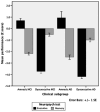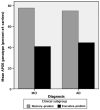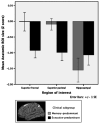Dysexecutive versus amnesic phenotypes of very mild Alzheimer's disease are associated with distinct clinical, genetic and cortical thinning characteristics
- PMID: 20562467
- PMCID: PMC3023235
- DOI: 10.1136/jnnp.2009.199505
Dysexecutive versus amnesic phenotypes of very mild Alzheimer's disease are associated with distinct clinical, genetic and cortical thinning characteristics
Abstract
Objective: To investigate whether some patients with very mild Alzheimer's disease (AD) demonstrate disproportionate executive dysfunction relative to amnesia and how this relates to functional impairment in daily life, future clinical decline, APOE genotype and regional cortical thickness measured from MRI scan data.
Methods: The Alzheimer's Disease Neuroimaging Initiative dataset was interrogated for a primary sample of patients with very mild AD dementia (n=100) and a secondary confirmatory sample of patients with mild cognitive impairment (n=396). An executive predominant subgroup was defined as having executive performance ≥2 SDs worse than memory performance and a memory predominant subgroup was defined conversely. A priori regions of interest from a previous study of an AD patient sample were used to obtain cortical thickness measures.
Results: Despite equivalent global measures of impairment (Mini-Mental State Examination, Clinical Dementia Rating (CDR) Sum of Boxes), executive predominant patients (n=88) were more impaired on other executive measures and in the CDR Judgement and Problem Solving box (p<0.005) while memory predominant patients (n=56) were more impaired on other memory measures (p<0.05). The APOE-ε4 allele was much more frequent in the memory predominant subgroup (p<0.0001). Frontoparietal cortical regions were thinner in the executive predominant group than in the memory predominant group (p<0.05).
Conclusions: A dysexecutive clinical phenotype of very mild AD is not rare and is associated with more problem solving difficulties and possibly more rapid progression compared with patients with a predominant amnesic phenotype. Executive predominant AD may reflect an alternative underlying pathophysiology related to genetic status, reflected in more prominent pathological alterations in frontoparietal regions subserving executive function. These findings, which deserve further investigation, may have implications for diagnosis, prognostication, monitoring and related issues involved in clinical research and care.
Conflict of interest statement
Figures




References
-
- McKhann G, Drachman D, Folstein M, et al. Clinical diagnosis of Alzheimer's disease: report of the NINCDS-ADRDA Work Group under the auspices of Department of Health and Human Services Task Force on Alzheimer's Disease. Neurology. 1984;34:939–44. - PubMed
-
- American Psychiatric Association. Diagnostic and statistical manual of mental disorders. 4th. Washington, DC: American Psychiatric Association; 1994.
-
- Arnold SE, Hyman BT, Flory J, et al. The topographical and neuroanatomical distribution of neurofibrillary tangles and neuritic plaques in the cerebral cortex of patients with Alzheimer's disease. Cereb Cortex. 1991;1:103–16. - PubMed
-
- Brun A, Gustafson L. Distribution of cerebral degeneration in Alzheimer's disease. A clinico-pathological study. Arch Psychiatr Nervenkr. 1976;223:15–33. - PubMed
-
- Dubois B, Feldman HH, Jacova C, et al. Research criteria for the diagnosis of Alzheimer's disease: revising the NINCDS-ADRDA criteria. Lancet Neurol. 2007;6:734–46. - PubMed
Publication types
MeSH terms
Substances
Grants and funding
- P50-AG005134/AG/NIA NIH HHS/United States
- P30 AG010124/AG/NIA NIH HHS/United States
- R01 AG029411/AG/NIA NIH HHS/United States
- P30AG010124/AG/NIA NIH HHS/United States
- R01-AG29411/AG/NIA NIH HHS/United States
- P50 AG005134/AG/NIA NIH HHS/United States
- R21-AG29840/AG/NIA NIH HHS/United States
- R21 AG029840/AG/NIA NIH HHS/United States
- P30 AG062421/AG/NIA NIH HHS/United States
- U01 AG024904/AG/NIA NIH HHS/United States
- U19 AG010483/AG/NIA NIH HHS/United States
- K23-AG028018/AG/NIA NIH HHS/United States
- K23 AG028018/AG/NIA NIH HHS/United States
LinkOut - more resources
Full Text Sources
Medical
Miscellaneous
